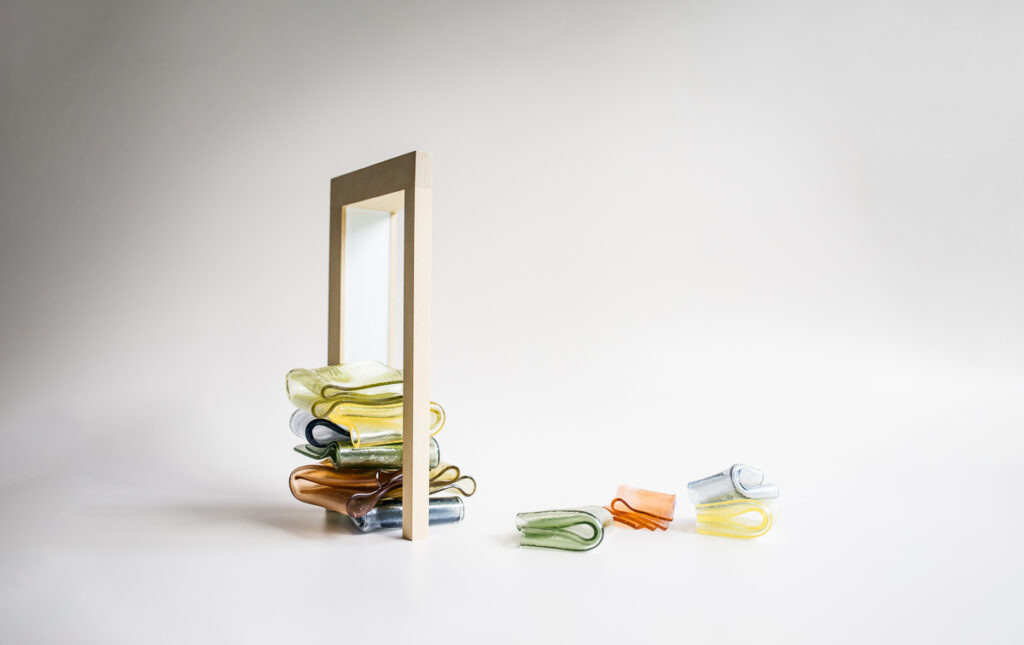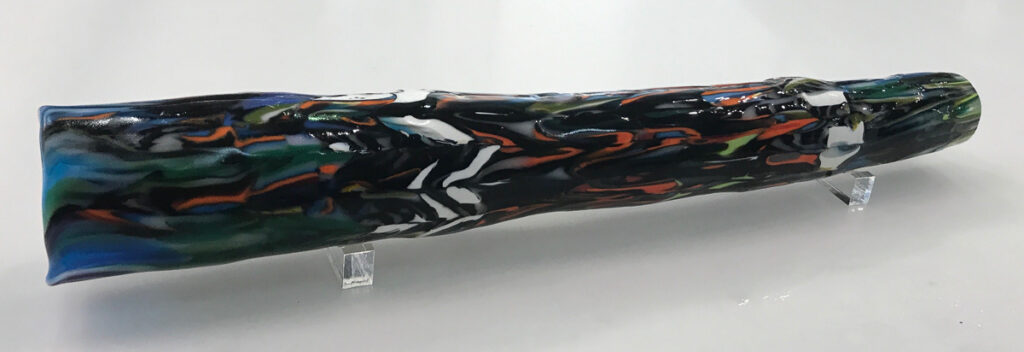
REA Kirstie, with Care, 2020. Photo Lean Timms
The theme of the 2020 Canberra Design Festival reflects a growing appreciation of care in how we design and make.
“‘Take care’, my father used to say, when first instructing Robert in the art of blowing glass. ‘Control is of supreme importance. One false movement and the expanding glass will be shattered’.”
Daphne du Maurier’s 1963 novel The Glass-Blowers makes much of the care required in the workshop. The author extends this trait to family relations, implying that this exercise of care in the workshop strengthens the capacity to bring up children well.
But care isn’t everything. Glenn Adamson’s essay for CraftACT argues for a balance of care in craft. While craft skill is characterised by great sensitivity to materials and consideration of use, it is also counterbalanced by productivity and the demands of the world. For Adamson, this has particular value in a time when the body politic shows an excess of care, reflected in polarisation that has crippled many democracies.
There is another dialectic of care in craft. Handmade objects have a singularity that makes them vulnerable to the vicissitudes of life. Unlike objects in the cloud, our sentimental jewellery, familiar cups and loved scarves can be lost and broken. Rather than lessening their value, these objects solicit a care that fills a world with meaning. We are needed.
We readily associate consumerism with the hoarding of objects. But arguably the larger part of our consumption involves care for others. This includes not just food for the family, but the care of pets and plants. The neediness of these beings is what attracts us.
I write this on the first day out of lockdown in Melbourne. The return of life on the street, coinciding with a rare glimpse of spring sunshine, is an irredeemably happy occasion. However, life is not objectively better than before. The joy comes from fixing something that was broken.
There are crafts that deliberately inspire this relief, such as the Japanese art of kintsugi, which fills the cracks of a broken ceramic bowl with gold leaf. The Japanese boro fabrics also extend this to elegant textiles patched together from discards.
With fortunate timing, what we see in this year’s Canberra Design Festival are works that creatively engage with this vulnerability.
Kirstie Rea’s glass blankets are particularly intriguing. These delicate forms offer a kind of cold comfort. She takes a form that signifies the primal comfort since we were infants and renders it in a material that is extremely breakable.
Over a COVID-safe phone call, I learnt from Kirstie that the glass blanket was conceived while teaching in Alberta in the middle of a Canadian winter. Kirstie was struck by a similarity of space in the skies of both countries, though the blue was much softer. This imbued Kirstie with a feeling of comfort and warmth to cover the distance from home.
Kirstie writes in her journal:
“Exploring alone in places beyond the suburban, place soaks deep under my skin and wraps around me. Back home memory and being there cling to me.”
Back home, Kirstie tells me that the forms now evoke for her the soft pastels of a Canberra autumn.

MARTINIELLO Jennifer Kemarre, Lorikeet Message Stick 3, 2020. Photo artist
These glass blankets are made from Bullseye glass over a series of four firings. The edges are engraved before layers touch down.
Bullseye glass has a strong Canberra back story. For the Craft ACT Member’s Exhibition, Jennifer Kemarre Martiniello has produced a message stick in glass in a wonderful tribute to Klaus Moje, who brought Bullseye glass to Canberra when he was teaching at the ANU School of Art. As well as being a token of safe passage, Martiniello describes the function of this object as being “to signify recognition or pay tribute to someone.” Traditionally, message sticks are normally carved from wood. The glass version suggests greater care is necessary for passing on the message.

COHEN Sarit, Looking Through, 2019. Photo Brenton McGeachie
We see an echo of this fragility in the works by Sarit Cohen in the Craft ACT Member’s Exhibition. She deviates from her more monumental bookish forms with a much more abstract vessel, whose main decorative feature is a tear. It is as though they hold together a wounding experience.
There are many other activities at the festival which evoke care in the making. The People’s Weaving Academy involves a recovery of value from recycled textiles, echoing the re-building of community ties. And at an individual level, Sharon People’s guided stitch meditation offers an experience for holding ourselves together. It reflects the Sufi practice of bakhiya meditation that is performed while suturing a garment.
Notable in this festival is a tour of Canberra’s mid-century architectural heritage. This includes Roy Grounds organic Shrine Dome (1959), Wyabelena Grove experimental bush housing (1974) and Harry Seidler’s geometrical Edmund Barton building (1970). Though a relatively new capital city, Canberra hasn’t been subject to the manic development of cities such as Sydney. This makes Canberra relatively rich in heritage for its age.
It’s not often we see heritage feature in a design festival. The lens of modernism has a short focus: the past is seen as a flawed 1.0 version of the present 2.0. There was a tendency around the millennium to associate the word “contemporary” with the creative arts. While it may connote relevance to the living, “contemporary” encourages a kind of amnesia which forgets the influence of the past on which we build, as well as the future horizon it projects forward.
There are signs that the past is catching up. The Defining Moments lecture series at the Australian Centre for Contemporary Art looks back on key exhibitions in the twentieth century that have shaped Australian art. The contemporary is something which now has gathered a history. Presentism, as a belief in the exceptionalism of our time, deprives us of the lessons of the past.
The past binds us together. Bonnie Honig’s concept of the “public thing” helps us understand the desire to preserve our architectural heritage. For Honig, much politics is animated by the contest over “public things”. Objects like museums, parks, iconic statues imply a collectivity that cares for them over time. When they are threatened, we are galvanised. Their predicament activates our collective fabric.
Honig provides a psychoanalytic explanation for the particular value of the public thing. It relates to how we develop a sense of self in the world. Drawing on Winnicott, she argues that our sense of a mature durable self is taught to us in the “transitional objects” that withstand the violence of the world. Transitional objects are characterised by their repair: the teddy bear whose eye is sewn back on. For Honig, this primary emotional investment in objects creates a framework for political engagement in later life.
Honig’s perspective is not being extended to design. The fetishisation of innovation has privileged “disruption” as a brave disavowal of inherited systems. In their book The Innovation Delusion, Lee Vinsel and Andrew L. Russell demonstrate how the necessary maintenance of our world has been systematically undervalued in favour of heroic invention of the new. This is epitomised in the mantra at Facebook “Move fast and break things.”
If anything, the pandemic has reminded us of the key role played by those on the “front line” who keep our world running: those precarious forms of labour such as stacking food on the shelves, delivering purchases, disinfecting spaces and caring for our bodies.
The meaning of “maintain” comes from the Latin manu tenere, “to hold in the hand”. At a time when holding or shaking hands with each other is not permitted, we appreciate even more the care necessary for our world to exist. It’s a particularly apposite theme for a design festival in 2020.
Canberra Design Festival is produced by Craft ACT, 9-29 November 2020

